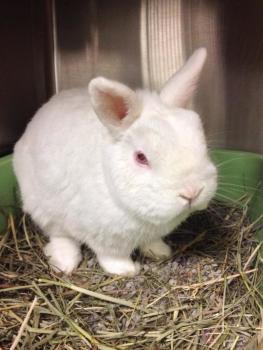Netherland Dwarf Rabbit
Category: Rabbit

Facts about Netherland Dwarf Rabbits. The Netherland Dwarf Rabbit is one of the first major “dwarf†breeds of rabbits and originated in the Netherlands, hence the name. The Netherland Dwarf Rabbit first appeared in the early 1900s. The Netherland Dwarf Rabbit grew in popularity after selective breeding improved its disposition.
The Netherland Dwarf Rabbit breed has been accepted by both the American Rabbit Breeder’s Association and British Rabbit Council.
Appearance of Netherland Dwarf Rabbit
Netherland Dwarf Rabbits have short fur. The Netherland Dwarf Rabbit come in a variety of colors, from white to black, brown and tan, orange and dual colored with various patterns. There are white Netherland Dwarf Rabbits with blue eyes and red. However, most Netherland Dwarf Rabbits with patterns are disqualified for show.
Physical Characteristics of Netherland Dwarf Rabbit
Netherland Dwarf Rabbits range from one to three and a half pounds full grown.
Netherland Dwarf Rabbits have upright ears. They have a short and round face. Their bodies are compact and rounded.
Behavior of Netherland Dwarf Rabbit
While the first Netherland Dwarf Rabbits had an aggressive temperament and fear of humans, selective breeding means modern rabbits are much more gentle than their predecessors and make suitable pets. However, Netherland Dwarf Rabbits are more active, energetic, and skittish than many other rabbit breeds. This is because they were bred from small wild rabbits up until the 1970s.
The side effect of this breeding is that the Netherland Dwarf Rabbit that isn’t as skittish or aggressive as its wilder ancestors handles handling and play better than more docile varieties. Since they are small, they are still prone to broken bones if dropped.
Care and Up keep of Netherland Dwarf Rabbit
Netherland Dwarf Rabbits can eat rabbit pellets, but they should eat hay several times a week to ensure good digestion. Alfalfa provides the high caloric content necessary for baby bunnies development. Once rabbits reach seven months of age, gradually switch them over to timothy hay, oat hay, or orchard grass. Don’t give the Netherland Dwarf Rabbit grass, since this goes bad quickly and doesn’t provide as much fiber as vegetables like carrots and dark leaf lettuce. (Iceberg lettuce contains too much water and too little fiber to be suitable.) Limit giving them fruit with sugar in it. Give the Netherland Dwarf Rabbit fresh water every 24 hours. Give them rabbit safe chew toys or hay to chew on.
If the Netherland Dwarf Rabbit’s diet changes too much, such as someone giving them too much variety, or the rabbit receives inappropriate foods, the rabbit can develop gut stasis. This can cause illnesses like diarrhea or even death.
Provide the Netherland Dwarf Rabbit safe bedding or wood pellets as a bedding and change it out frequently. Be careful to use cleaners for the cage that are safe for pets; not all cleaning compounds are safe for use around pets. If in doubt, clean it with white vinegar.
All Netherland Dwarf Rabbits are sensitive to significant temperature changes of more than 15F, and temperatures over 90F are dangerous to them. If it is really hot outside, keep the Netherland Dwarf Rabbit inside or in a shaded hutch with a frozen water bottle to keep them cool. Don’t carry the Netherland Dwarf Rabbit inside an air conditioned home from 95F weather or it may kill the animal from shock.
Place their cages far from noisy appliances like air conditioners and refrigerators.
Trivia about Netherland Dwarf Rabbit
The Netherland Dwarf Rabbit is the source of the recessive dwarf gene that makes many other breeds half the size (or less) of wild rabbits. The Netherland Dwarf Rabbit is the foundation breed for many dwarf or “compact†rabbit modern breeds raised to be pets for apartment dwellers instead of food or fur animals.
Pet Netherland Dwarf Rabbits should be kept in pairs for Companionship, its important for a rabbits happiness and it can live longer with a companion. In the wild, rabbits are very social. Female Netherland Dwarf Rabbits can produce about 2 to 4 litters of bunnies per year with 4 to 6 babies.
Netherland Dwarf Rabbit. "Scientific name for Rabbit Oryctolagus cuniculus". "Fear of Rabbits Leporiphobia". All rabbit breeds are "lagomorphs" various plant-eating mammal of the order Lagomorpha ; a hare, rabbit, or pika.
Netherland Dwarf Rabbits are born with without fur and its eyes closed. Half of the rabbits in the world live in North America. Netherland Dwarf Rabbits are comfortable living in groups. European rabbits like to live in burrows underground. Warren is known as a group of burrows. Cottontail Rabbits are the only rabbit that does not live under ground.
Netherland Dwarf Rabbits have an outstanding sense of vision, smell and hearing. Having eyes on the side of their head and being so big, gives them nearly 360 degrees vision, allowing the Netherland Dwarf Rabbit to see predators from all directions. They can see everything behind and in front of them and have just a small blind-spot in front of their nose.
The average lifespan of a Netherland Dwarf Rabbit is around 5 to 8 years and in captivity can live up to 10 years. Netherland Dwarf Rabbits have 28 teeth and an incredible fact, a rabbit’s teeth never stop growing throughout its life.
Netherland Dwarf Rabbits are very clean animals and will groom themselves and also each other. Netherland Dwarf Rabbits are crepuscular-(meaning the are most active at morning and evening) and do most of there feeding in the evening. Netherland Dwarf Rabbits on average sleep about 8 hours.
The male Netherland Dwarf Rabbit is called a buck and a female Netherland Dwarf Rabbit is called a doe, also both known as a bunny. A young rabbit is called a kit "kitten" or baby bunny.
Netherland Dwarf Rabbits are herbivores (a herbivore, eats leaves, grass, hay and furns (plant eaters) and also mammal.

 Back To Category Rabbit
Back To Category Rabbit